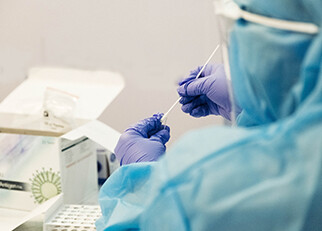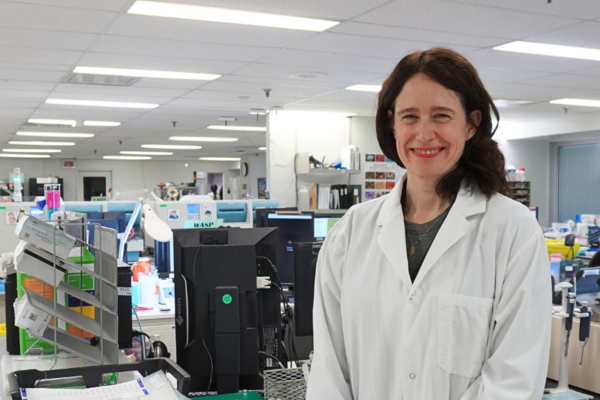A rapid test but not a rapid solution for COVID-19

As the COVID-19 pandemic continues to unfold, an increasing number of testing devices are being released. Most recently, ‘rapid’ testing, some of which are point-of-care tests (POCT), has become a focus as priorities shift towards receiving faster results.
The Department of Laboratory Medicine & Pathobiology in the Temerty Faculty of Medicine looks at rapid testing and what it means.
Written by LMP appointed faculty, Dr. Jennifer Taher, Clinical Biochemist at Mount Sinai Hospital, Dr. Vanessa Tran, Clinical Microbiologist at Public Health Ontario and Dr. Jonathan Gubbay, Medical Microbiologist at Public Health Ontario.

Why are rapid tests not the norm?
‘Point-of-care’ means the test may be performed by non-laboratory staff at the patient bedside or clinic. In fact, some rapid devices can even be performed at home, with common examples including glucometers for diabetes monitoring or home-based pregnancy tests. However, COVID-19 POCT are currently only used outside of the home, for example at remote hospitals or long-term care facilities.
Rapid COVID-19 testing includes three main types:
- Polymerase chain reaction (PCR)/nucleic acid tests
- Antigen tests
- Serology/antibody tests
There are multiple benefits to having rapid COVID-19 tests available.
While it may take several days to get results from the laboratory-based COVID-19 PCR testing, rapid tests can provide results within 15-30 minutes. A reduced turnaround time is particularly useful in outbreak scenarios as infected patients can be isolated more rapidly and the spread can be contained.
It also allows remote areas, without access to central laboratories, to receive results quickly by eliminating transportation delays.
Rapid tests may help to alleviate the workload issues that laboratories currently face with extremely high volumes of PCR tests.
It appears rapid testing can solve many problems and is an ideal alternative to laboratory-based tests. Why then are we not resorting to rapid testing and why is laboratory-based PCR still the gold standard?
The answer is because these tests are not without their own limitations in test performance and are only useful when used in the right context.
In addition, does not lessen the workload since substantial resources, such as personnel to administer the test and the need for confirmatory testing by PCR in many instances, are required.
There is also a need for quality control to implement and run a rapid testing program to ensure that quality of testing is maintained.
Understanding test performance
No test is perfect; however, some tests are better than others.
Test sensitivity and specificity are key performance characteristics. Understanding these parameters is important in the context of COVID-19 testing.
Sensitivity
Refers to the ability to detect patients with COVID-19, and low sensitivity would indicate a higher false negative rate. To complicate matters, test sensitivity is not consistent throughout the time course of COVID-19 infection and will differ depending on the time the sample was taken after the patient was infected and how that sample was collected. The highest sensitivity occurs when viral loads are high which occurs early on in infection.
Specificity
The ability to correctly result a test as negative when performed on a person without COVID-19, therefore a low specificity would indicate a higher false positive rate.
Because of the potential for inaccurate results and differences in test performance characteristics, test results should be interpreted according to pre-test probability including risk of exposure, presence and duration of symptoms, and population prevalence.
Prevalence is important because ‘predictive’ values play a significant role in result interpretation. In patient populations with a lower prevalence of COVID-19, there is a higher chance that a positive result is a false positive, and the test would have a low positive predictive value. Conversely, in populations with a higher prevalence of COVID-19, the false positive rate decreases and the test would have a high positive predictive value.
1. Rapid Nucleic Acid Testing
As of February 2020, Health Canada has approved five nucleic acid rapid testing devices that use similar technology to the current laboratory-based PCR method.
Appropriate sample types include nasopharyngeal swabs, nasal swabs and nasal wash aspirates depending on the instrument vendor. These have been mostly studied for use in symptomatic patients within the first week of experiencing symptoms.
Their use is promising and test results are primarily used in a diagnostic setting, although screening of asymptomatic patients may also be performed in high-risk populations such as long-term care facilities.
The sensitivity of most rapid nucleic acid tests is lower compared to laboratory-based methods and fewer samples can be tested at one time. The lower sensitivity increases the risk of a false negative result. This can also occur if samples are taken too early or too late. Incorrect sample collection or handling and the pre-test probability of a patient population can also contribute to false negative or positive results. Because of this, parallel or repeat testing with a laboratory-based PCR test is required in some situations.
2. Rapid Antigen Testing
Health Canada has currently approved four rapid antigen testing devices which employ lateral flow immunoassay technology similar to home-based pregnancy tests.
Appropriate sample types include nasopharyngeal swabs and/or nasal swabs depending on the instrument vendor. Similar to rapid nucleic acid testing, Health Canada authorization for use of rapid antigen tests have been focused on symptomatic testing in the early phase of illness.
Antigen tests have lower sensitivity when compared to laboratory-based PCR testing and although they have demonstrated high specificity, false positive results can still occur. Due to this, rapid antigen testing is not recommended for diagnosis when laboratory-based PCR testing is readily available.
If rapid antigen testing is performed, parallel or confirmatory testing by laboratory-based PCR may be required depending on the intended use. This is when the prevalence and pre-test probability are important considerations. In general, all positive rapid antigen tests may need to be confirmed, although believe given the godd specificity that it is not necessary.
Negative rapid antigen tests should be confirmed when testing symptomatic individuals or contacts of confirmed COVID-19 cases.
In Ontario, rapid antigen tests are recommended for repeated screening of asymptomatic individuals. For example, rapid antigen testing is being used for screening in semi-closed communities such as long-term care homes, correctional facilities, and workplaces.
In situations where the pre-test probability is low, provided persons can be tested repeatedly (e.g. twice per week), a negative rapid antigen screen test in asymptomatic individuals likely does not need to be confirmed.
3. Rapid Serology Testing
To date, there are two Health Canada approved COVID-19 point-of-care serology tests. Several comparative studies have shown that in general, rapid serology tests have poor performance compared to laboratory-based methods and it is still unclear whether these tests have utility.
While nucleic acid and antigen tests detect the presence of SARS-CoV-2, serology detects the presence of antibodies that are produced as an immune response after exposure to SARS-CoV-2.
There are various antibody isotypes but isotypes commonly measured are IgM antibodies produced in early response and IgG antibodies produced later on and are usually detected after 14 days from symptom onset.
Laboratory-based COVID-19 serology assays currently available detect either total (IgM, IgA and IgG) or IgG antibodies in blood samples. Most commonly this would be through a venous blood draw although several research studies are investigating ability to perform this type of testing on finger prick samples to aid in home collections. IgA antibodies are also being investigated but mainly in a research setting, with the potential use for detection in saliva which is a less invasive sample type.
Unlike nucleic acid and antigen tests, the test sensitivity for COVID-19 serology is highest after 14 days post-infection, given that it takes time for antibodies to be produced.
COVID-19 antibody dynamics are still being investigated and thus the utility in measuring antibodies for diagnostic purposes has remained limited. Some antibodies have viral neutralizing abilities; however, this characteristic is not directly detectable by tests available in clinical laboratories in Ontario or by rapid serology tests. How long neutralizing antibodies remain is also not well understood.
Serology testing in general may have utility in detection of patients that previously had COVID-19. It is not yet known whether the detection of antibodies indicates that a person is immune, therefore it cannot be used to determine if someone is protected from future infection. Further, currently available tests cannot adequately distinguish between antibodies from a person who was infected with the COVID-19 virus and a person who received the COVID-19 vaccine.
Will rapid serology testing be used as proof of vaccination status or as an “immunity passport”?
Likely not. There is still too much unknown about how long antibodies last and whether their presence means that someone is protected.
Will rapid testing provide a rapid solution for the pandemic?
Rapid COVID-19 testing is unfortunately not a fast way out of the pandemic as these tests have many limitations.
None-the-less, when used in the correct settings, they can add significant benefit by leading to faster isolation of infected individuals, providing testing to remote communities, and potentially helping to reduce laboratory workload volumes.
Laboratory-based testing continues to play a vital role in the COVID-19 pandemic and research studies may help to uncover additional clinical utilities for rapid COVID-19 tests.
Quick reference overview of COVID-19 testing
|
|
Laboratory-based PCR |
Rapid molecular test |
rapid antigen test |
rapid serology test |
|---|---|---|---|---|
|
what it detects |
Virus genetic material (RNA) |
Virus genetic material (RNA) |
Virus protein (antigen) |
Human antibodies developed in response to virus |
|
when test should be taken |
Early in infection |
Early in infection |
Asymptomatic |
Later in infection (after 14-21 days) |
|
specimen type |
Upper respiratory tract swab |
Upper respiratory tract swab |
Upper respiratory tract swab |
Blood |
|
how it should be used |
Diagnostic |
Diagnostic or screening |
Repeated screening of asymptomatic individuals |
To determine exposure |
|
how long it takes to process |
1 - 4 days |
15 min – 1 hour |
15 – 20 min |
15 – 30 min |
|
current uses in ontario |
Gold standard for diagnosis of acute COVID-19. |
Remote communities, early outbreak investigation. Parallel or repeat testing by PCR may be required. |
Asymptomatic screening of healthcare workers, workplaces in low prevalence settings. Parallel or repeat testing by PCR may be required. |
Not currently recommended for use. |
See also AACC Issues Updated Recommendations on the Uses and Limitations of Coronavirus Antibody Tests: Dr. Lusia Sepiashvili was part of the American Association for Clinical Chemistry task force that put together recommendations for implementing and interpreting COVID-19 serology assays in clinical labs.
Our COVID-19 focus
Find out more about research and education related to COVID-19 from the Department of Laboratory Medicine & Pathobiology.
Microbiologists: the unsung heroes of the pandemic
Image credits: JC Gellidon and Waldemar Brandt via Unsplash



